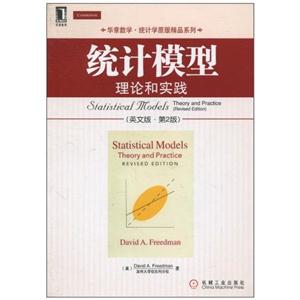-
>
妙相梵容
-
>
基立爾蒙文:蒙文
-
>
我的石頭記
-
>
心靈元氣社
-
>
女性生存戰爭
-
>
縣中的孩子 中國縣域教育生態
-
>
(精)人類的明天(八品)
統計模型-理論和實踐-第2版-英文版 版權信息
- ISBN:9787111317975
- 條形碼:9787111317975 ; 978-7-111-31797-5
- 裝幀:暫無
- 冊數:暫無
- 重量:暫無
- 所屬分類:>>
統計模型-理論和實踐-第2版-英文版 本書特色
《統計模型:理論和實踐(英文版·第2版)》是華章數學·統計學原版精品系列。
統計模型-理論和實踐-第2版-英文版 目錄
統計模型-理論和實踐-第2版-英文版 節選
《統計模型:理論和實踐(英文版·第2版)》內容簡介:Some books are correct. Some are clear. Some are useful. Some are entertaining. Few are even two of these. This book is all four. Statistical Models: Theory and Practice is lucid, candid and insightful, a joy to read. We are fortunate that David Freedman finished this new edition before his death in late 2008. We are deeply saddened by his passing, and we greatly admire the energy and cheer he brought to this volume——and many other projects——-during his final months.
統計模型-理論和實踐-第2版-英文版 相關資料
插圖:Epidemiological studies often make comparisons separately for smaller and more homogeneous groups, assuming that within these groups, subjects have been assigned to treatment or control as if by randomization. For ex- ample, a crude comparison of death rates among smokers and nonsmokers could be misleading if smokers are disproportionately male, because men are more likely than women to have heart disease and cancer. Gender is there- fore a confounder. To control for this confounder——a third use of the word "control"——epidemiologists compared male smokers to male nonsmokers, and females to females.Age is another confounder. Older people have different smoking habits, and are more at risk for heart disease and cancer. So the comparison between smokers and nonsmokers was made separately by gender and age: for ex- ample, male smokers age 55-59 were compared t male nonsmokers in the same age group. This controls for gender and age. Air pollution would be a confounder, if air pollution causes lung cancer and smokers live in more polluted environments. To control for this confounder, epidemiologists made comparisons separately in urban, suburban, and rural areas. In the end, explanations for health effects of smoking in terms of confounders became very, very implausible.Of course, as we control for more and more variables this way, study groups get smaller and smaller, eaving more and more room for chance effects. This is a problem with cross-tabulation as a method for dealing with confounders, and a reason for using statistical models. Furthermore, most observational studies are less compelling than the ones on smoking. The following (slightly artificial) example illustrates the problem.Example 1. In cross-national comparisons, there is a striking correlation between the number of telephone lines per capita in a country and the death rate from breast cancer in that country. This is not because talking on the telephone causes cancer. Richer countries have more phones and higher cancer rates. The probable explanation for the excess cancer risk is that women in richer countries have fewer children. Pregnancy——especially early first pregnancy——is protective. Differences in diet and other lifestyle factors across countries may also play some role.
統計模型-理論和實踐-第2版-英文版 作者簡介
作者:(美國)弗里德曼(David A.Freedman)David A.Freedman(1938-2008)是加州大學伯克利分校的統計學教授、杰出的數理統計學家,其研究范圍包括鞅不等式分析、Markov過程、抽樣、自助法等。他是美國科學學院(American Academy of Art and Sciences)院士。在2003年,美國科學院授予他John J.Carry科學進步獎,以表彰他對統計理論和實。
- >
名家帶你讀魯迅:朝花夕拾
- >
我與地壇
- >
巴金-再思錄
- >
自卑與超越
- >
羅庸西南聯大授課錄
- >
隨園食單
- >
大紅狗在馬戲團-大紅狗克里弗-助人
- >
月亮與六便士

















